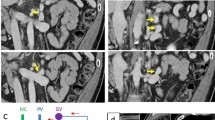Abstract
A 63-year-old woman diagnosed as having hepatic hilar cancer underwent an extended left lobectomy of the liver with excision of the right hepatic artery which was involved by the tumor. Because the hepatic artery could not be reconstructed by direct anastomosis, an artificial arterioportal (A–P) shunt was constructed between the common hepatic artery and the portal vein. However, 4 weeks after the operation, portal hypertension with severe esophageal varices developed. Under the diagnosis of portal hypertension caused by excessive blood flow from the A–P shunt, coil embolization of the common hepatic artery was performed using an angiographic technique, following which the esophageal varices completely disappeared. This case demonstrates that portal hypertension after A–P shunting can be effectively treated with coil embolization.
Similar content being viewed by others
References
Lygidakis NJ, Heyde MN, Dongen RJAM, Kromhout JG, Tytgat GNJ, Huibregtse K (1988) Surgical approaches for unresectable primary carcinoma of the hepatic hilus. Surg Gynecol Obstet 166:107–114
Iseki J, Touyama K, Noie T, Nakagami K, Takagi M, Hakamada K, Tanaka A, Yamada A, Hanakita J, Suwa H (1992) Partial portal arterialization for the prevention of massive liver necrosis following extended pancreatobiliary surgery: experience of two cases. Surg Today 22:568–571
Zuidema GD, Gaisford WD, Abell MR, Brody TM, Neill SA, Child CG (1963) Segmental portal arterialization of canine liver. Surgery 53:689–698
Van Way CW, Crane JM, Riddell DH, Foster JH (1971) Arteriovenous fistula in the portal circulation. Surgery 70:876–890
Stone HH, Jordan WD, Acker JJ, Martin JD (1965) Portal arteriovenous fistulas: review and case report. Am J Surg 109:191–196
Iñon AE, D'Agostino D (1987) Portal hypertension secondary to congenital arterioportal fistula. J Pediatr Gastroenterol Nutr 6:471–473
Ozawa K, Fujimoto T, Nakatani T, Asano M, Aoyama H, Tobe T (1982) Changes in hepatic energy charge, blood ketone body ratio and indocyanine green clearance in relation to DNA synthesis after hepatectomy. Life Sci 31:647–653
Benito M, Del Pino JG, Hernandez L, Pardo JD (1989) Lack of portal-venous hypertension after an arterioportal fistula in the rat. Microsurgery 10:194–201
Bilbao JI, Longo JM, Aquerreta JD, Rodriguez-Cabello J, Fernandez A (1990) Platinum wire embolization of an intrahepatic arterioportal fistula. Am J Gastroenterol 85:859–860
Author information
Authors and Affiliations
Rights and permissions
About this article
Cite this article
Ko, S., Nakajima, Y., Kanehiro, H. et al. Successful management of portal hypertension following artificial arterioportal shunting: Report of a case. Surg Today 25, 557–559 (1995). https://doi.org/10.1007/BF00311316
Received:
Accepted:
Issue Date:
DOI: https://doi.org/10.1007/BF00311316




